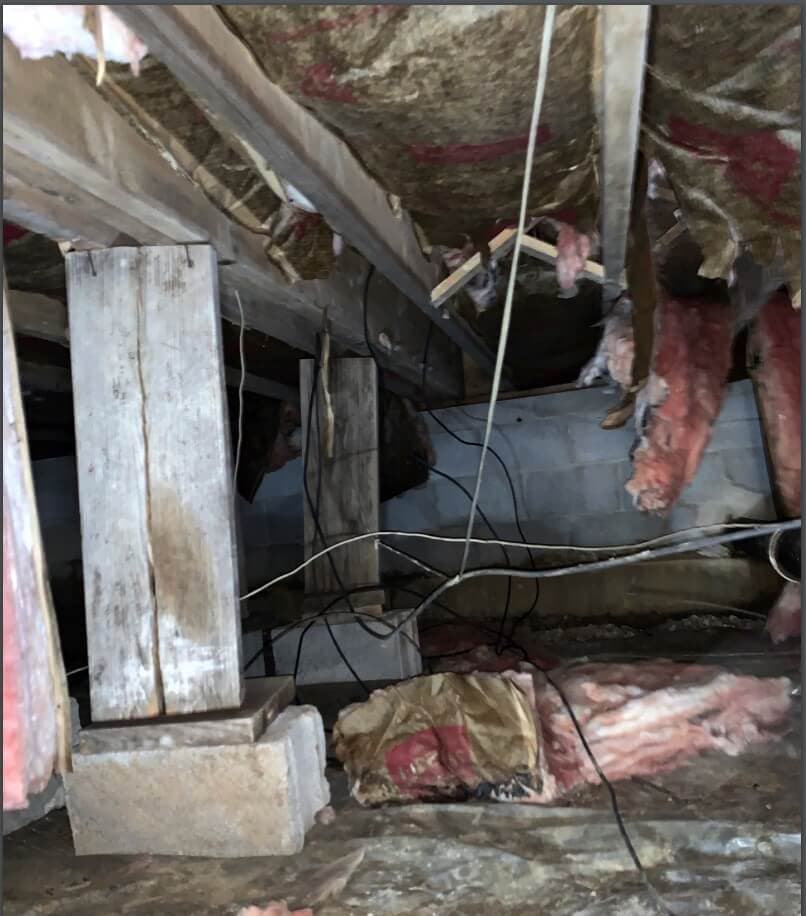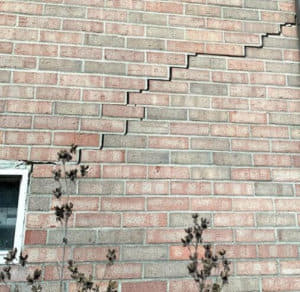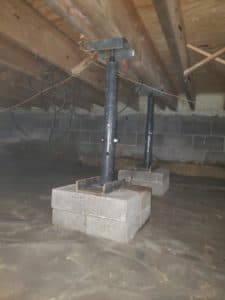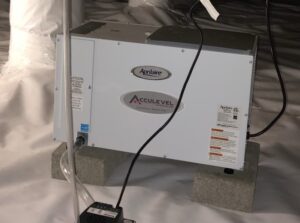
It’s a universal truth that families need a consistent budget to manage their expenses. This is a challenging task, given unpredictable weather patterns, fluctuating fuel prices, and rising food costs. High utility bills can put your household in a situation that is stressful, frustrating, and sometimes genuinely uncomfortable.
Do you resign yourself to lower temperatures in the winter, enduring cold feet and wearing multiple layers? Do you set the thermostat higher in the summer, struggling to sleep in muggy air?
You can sign up for your energy provider’s budget billing program, which can help with the unpredictability of your monthly bill. But it won’t lower it, and that’s really what we’re all looking for, isn’t it?
Acculevel is a family-owned and operated company that specializes in waterproofing and foundation repairs. We understand the concerns of homeowners and their desire to provide the best and healthiest environment for their families. Since our founding in 1996, we’ve improved the stability and value of 30,000+ homes, which can significantly improve energy efficiency.
We’ll explain how insulation and encapsulation are options that can help homeowners increase energy efficiency, protect against moisture damage, and improve indoor air quality.
Before we dive into foundation insulation options, we need to eliminate any existing drafts or weak points. Not only does this protect the longevity of your home, but it means you’ll be able to view areas now that may be hidden later by insulating materials.
You can hire a foundation repair expert to perform this type of in-home evaluation; many do this for a small fee or even as a courtesy (Acculevel provides free foundation inspections). But you can also do a preliminary review on your own! We’ve developed a step-by-step guide for homeowners that walks you through an evaluation of your interior and exterior foundation.
Access Our Free DIY Home Inspection Guide.
 This photo was taken by an Acculevel project advisor during a free in-home evaluation. This type of crack indicates the foundation is settling.
This photo was taken by an Acculevel project advisor during a free in-home evaluation. This type of crack indicates the foundation is settling.
Minor cracks in your crawl space or basement walls may not seem like a major concern, but these small fissures are more than enough for your home to develop drafts. Drafts allow your lovely filtered, temperature-controlled air inside to escape, while allowing the unmoderated air outside to find its way in. Your HVAC will work harder to maintain your temperature settings and be less successful at doing so.
This becomes a frustrating cycle — one kid cranks the thermostat up or down because they’re uncomfortable. Then it’s too much or not enough in another room, and another kid (or your spouse!) adjusts the thermostat again. Repeat this a few times per day, and it adds up to an uncomfortable family, a drafty house, an overworked HVAC, and a blown budget.
The DIY Guide includes some links to information that will help you if you find concerning signs of damage in a foundation wall. We also have a free detailed resource that reviews all foundation repair topics and questions.
Once you’ve taken the necessary steps to ensure your foundation exterior is protected and secure, it’s time to start evaluating the inside of your basement or crawl space.
For many years, home builders insulated everything with fiberglass batting. However, we’ve learned that it’s not the right insulation method for every area — and especially not in spaces that may become damp.
Fiberglass insulation absorbs moisture, which is bad for two major reasons:
Moisture intrusion is the leading cause of sagging floors. You will need to remove and correctly dispose of the fiberglass insulation. At that point, you’ll need to inspect the wooden components for signs of mold, termites, wood rot, etc. Once those items are repaired, then it’s time to install insulation that will actually stay in place and do its job.
Take a look at the photograph below. This was taken by an Acculevel project advisor during a free in-home evaluation of a customer’s crawl space. The fiberglass insulation is soggy and falling. There is mold growing on the joists and beam, and the wooden support columns are splitting.
 Crawl Space Before Repairs
Crawl Space Before Repairs
We recommend that homeowners replace fiberglass batting with spray polyurethane foam. Spray foam insulation repels moisture and locks into place; it adheres directly to the surface it’s sprayed on. It also thoroughly blocks all cracks and crevices, no matter how small; this eliminates drafts and makes your HVAC run more efficiently.
The R-Value of spray foam insulation is also double that of fiberglass batting. This value is the industry’s way to grade or rate how effective a material is at preventing heat transfer. A higher R-Value is generally seen as more energy-efficient and comfortable. *
The R-Value of fiberglass batting is 2.8 - 3.9; spray foam’s R-Value is 5.5 - 7.12.
[box type="info"] Please note: R-Value is not always the best way to measure a material. If you have multiple layers of an insulator, you will have a high R-Value. But if these layers still have gaps or permit drafts, you will still have cold floors.[/box]
If you just glance at the numbers, spray foam seems far more expensive than fiberglass, but don’t be fooled. You need to install far less foam, so they’re much closer than they look.
Foam is $14 per linear foot, and fiberglass is around $1.50 per square foot. Spray foam only needs to be applied to the perimeter of your basement or crawl space. Fiberglass insulation needs to be installed across the entire surface, between every joist.
Need a refresher on linear versus square footage? We explain how to calculate each:
Let us “crunch” the numbers for you. If your basement or crawl space is 1500 square feet, fiberglass is $2250, and spray foam is $2380. That’s a difference of $130 — and you can easily get that back in utility cost savings (plus have less moisture damage to your home).
 Crawl Space after repairs were made
Crawl Space after repairs were made
The photo above is from the same crawl space but was taken by an Acculevel team member after repairs. All of the fiberglass batting was removed, and the joists and beams were treated and repaired. We also installed replacement support columns with jacks. If you look closely, you can see the spray foam insulating the top of the crawl space walls.
Want to learn more about the advantages of spray foam insulation (and get the breakdown on the math)? We have a deeper dive into the topic here.
Encapsulating basements and crawl spaces is the ideal way to protect them against water intrusion. It involves applying a heavy plastic liner to the interior walls. (In a crawl space, the white cap is also used to cover the exposed ground.)

This photo was taken by an Acculevel team member after installation. You can see the white cap covers the floor of the crawl space, is wrapped around the support columns, and has been tightly sealed around the sump pump and dehumidifier drainage lines.
Encapsulation does require a water drainage system to be installed to prevent water from collecting under the liner. You also need a dehumidifier to manage potential condensation.
An encapsulated crawl space has superior interior air quality, maintains low humidity, reduces strain on your HVAC system, and creates a clean environment suitable for storage. We have an article that goes into detail about crawl space encapsulation here.
 This photo, also taken by an Acculevel team member, shows an encapsulated basement.
This photo, also taken by an Acculevel team member, shows an encapsulated basement.
We recommend homeowners encapsulate their basements before they convert the area into living space. In addition to the benefits we’ve covered, it also ensures the drywall, carpet, and furniture will stay dry.
Encapsulation is particularly helpful for older homes with brick or stone foundation walls because these materials are more porous than concrete. You can learn more information about basement encapsulation in this article.
The white encapsulation liner Acculevel uses has an antimicrobial coating that inhibits mold growth and preserves the material against decay. Professional installation includes a 25-year warranty and costs $2-3 per square foot.
If you live in Indiana or the surrounding states, contact Acculevel. We are a family-owned and operated company, and we provide free written estimates. One of our experienced project advisors will evaluate your home and foundation insulation, then recommend the best course of action for you and your family.
If you’re outside our service area, please find an experienced and knowledgeable contractor to evaluate your home. We recommend that you verify the company is reputable, insured, and accredited by the Better Business Bureau.
[DISPLAY_ULTIMATE_SOCIAL_ICONS]